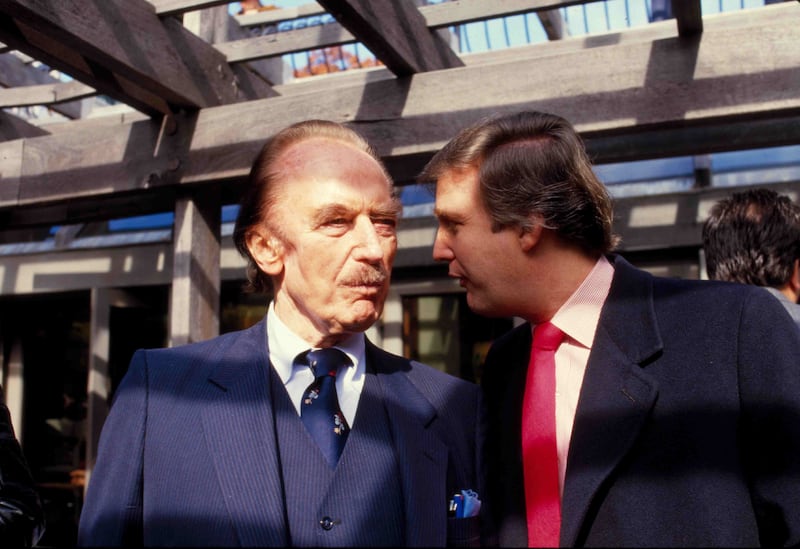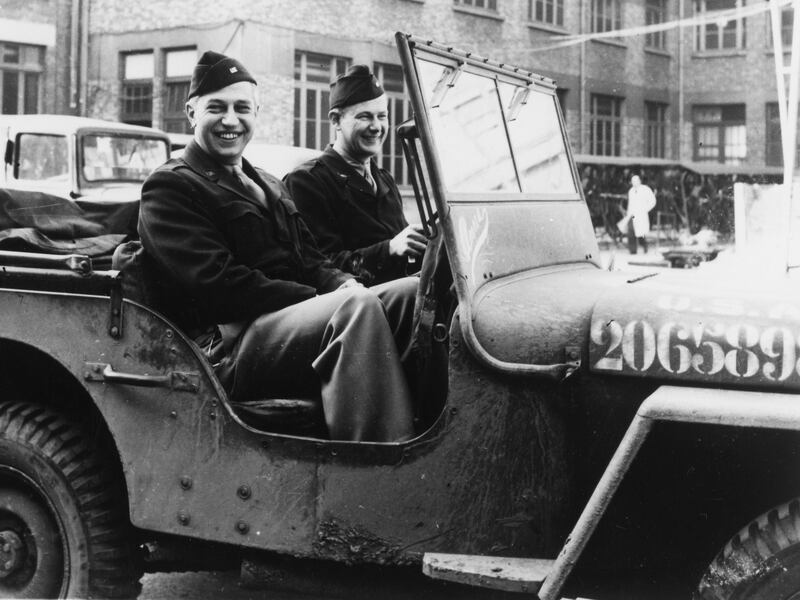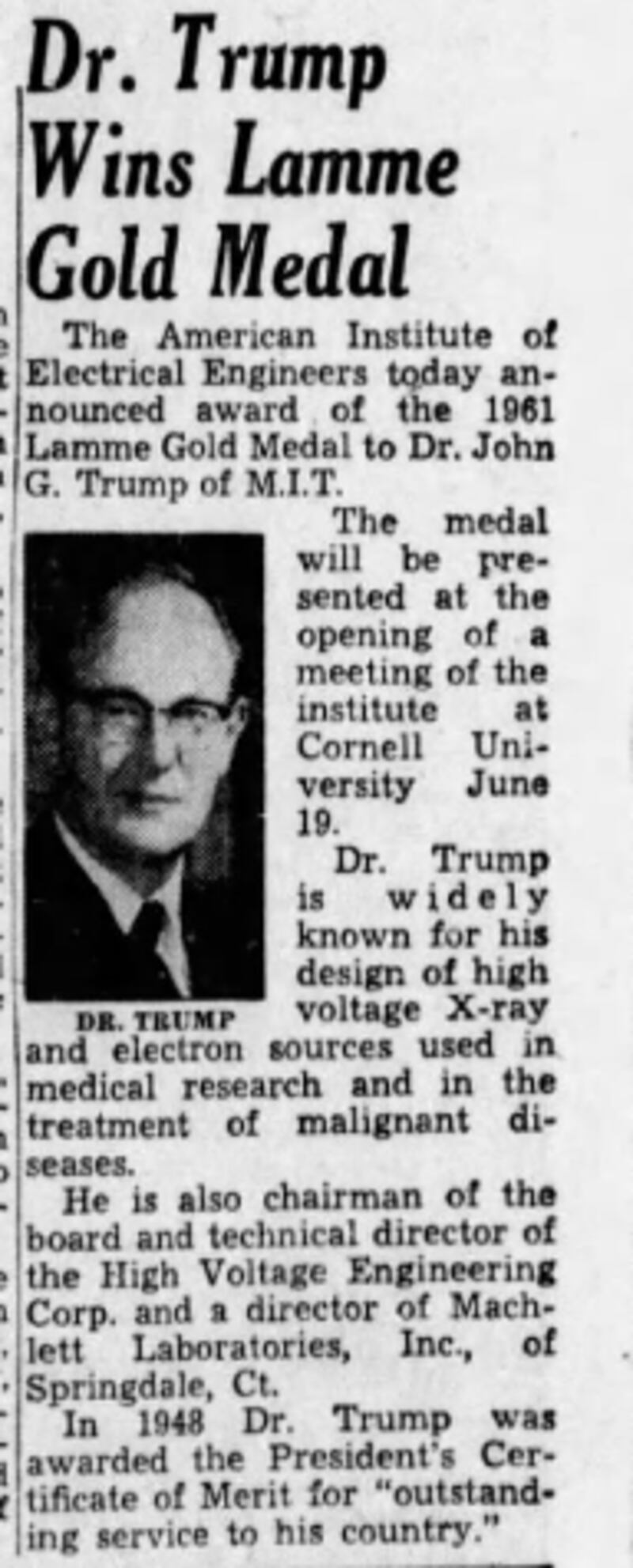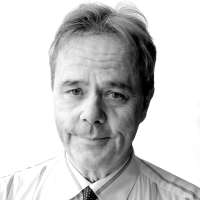As President Donald Trump seeks to defund, devalue and maybe destroy Harvard, another prestigious university a little over a mile away is escaping his unreasoning wrath.
Since Trump is always ultimately about himself, we can assume that the reason is one he has often been able to cite as supposed proof of his “good genes”: that his paternal uncle was a longtime professor of particular brilliance at the Massachusetts Institute of Technology.
“You know my uncle was a great—he was at MIT," Trump said in March 2020 while visiting the Centers for Disease Control headquarters in Atlanta.
“He taught at MIT for a record number of years,” Trump said “He was a great super genius, Dr. John Trump.”
John Trump did not teach for a record number of years, but he was a professor there for 44 years, the last seven as an emeritus researcher, receiving considerable federal funding throughout his decades there. And he was recognized as an actual stable genius among many who would have called themselves one.
“Genius, you have to be careful around here, we don’t throw those words around here very loosely,” O. Robert Simha, who helped John Trump develop a new laboratory facility at MIT in the 1960s, told the Daily Beast. “Everybody’s in the same business trying to make the world a little bit better, do interesting things, and he was a wonderful example of that. He made a great contribution.”
Among other things, John Trump made major advances in using radiation to treat cancer. He was the younger brother of Fred Trump, who went into the family business started by their widowed mother.

The brothers were so different as to be an example of what genetics cannot explain about siblings. Fred was notably tall, irritable, conniving and avaricious, an unpleasant bully given to garish clothing. John was short, and his sibling’s opposite in seemingly every way.
“He was remarkably even-tempered, with kindness and consideration to all, never threatening or arrogant in manner, even when under high stress,” fellow scientist Dennis Robinson wrote in his 1985 obituary of John Trump in Physics Today.
“He was outwardly and in appearance the mildest of men, with a convincing persuasiveness, carefully marshaling all his facts.”
Robinson further noted, “He cared very little for money and the trappings of money.”
John did not name his laboratory or anything else after himself. He did not tell his colleagues he had won a Presidential Medal for Science in 1983. They only found out when it was in the newspaper.
He had served his country with distinction: His citation with the National Science & Technology Medals Foundation notes, “During World War II, Trump went to work at the MIT Radiation Lab, which used microwave radar to help with the war effort. In 1944, Trump headed the lab’s British branch. After the liberation of Paris, he rode into the city with General Dwight D. Eisenhower to begin setting up a Paris branch for the lab.”
A longtime colleague remembers that at a memorial gathering at an historic church in Lexington, Massachusetts, following John’s death in February of 1985, Fred remained outside the entrance in an expensive-looking silk suit.

“He was just standing outside,” the colleague, noted medical physicist Bob Wenstrup, told the Daily Beast. ”He was not inside, where everybody else was. He was there just by himself, standing by the door, and with the impression that he was not going to go in there, and he was going to probably get the hell out of Dodge as soon as he could.”
Fred struck Wenstrup as dour and crude and generally nasty.
“He made no pretense of being civil,” Wenstrup remembered. “I shook his hand. I might have liked to cut it off.”
Wenstrup does not remember John’s nephew, Donald Trump, being there at all. But his uncle’s colleagues and the rest of the country came to know him.
“John was as different from his nephew as you can imagine, and so I don’t know why the DNA didn’t spread over to his brother Fred,” Sinha told The Daily Beast. “We haven’t figured that one out yet.”
Donald has nonetheless been quick to claim a genetic link to his genius Uncle John at MIT when in a place such as the CDC people might consider him to be a less-than-high-IQ individual.
And that is surely why President Trump has largely spared MIT while fixating on Harvard. International students make up 27.2 percent of the total enrollment at Harvard. They make up 28 percent of the total at MIT. But Donald Trump has said nothing about foreign students at MIT, while seeking to bar Harvard from enrolling any at all.

“We want those names and countries,” he posted online.
MIT has also been spared the ominous threats and demands regarding such matters as diversity and course content that Harvard declared unacceptable. Trump is moving to end Harvard’s tax-exempt status and cut some $8 billion in research funding.
To her great credit MIT president Sally Korbluth told the student newspaper The Tech that while the university is not seeking to provoke the Trump administration, it will stand up against “incursions into academic freedom.” She indicated what is at stake for the whole county by pointing out a 2015 report that figured MIT has started over 30,000 companies that earn some $1.9 trillion a year.
But while the uncle connection seems to have spared MIT from Trump’s wrath, the university is still joining a host of other institutions - and science itself - in suffering his ignorance/indifference when it comes to cutting funds for research.

“He’s been very respectful of his uncle’s achievements here, but one can’t really explain his mentality,” Simha said. “He has already done us a lot of damage.”
Simha continued, “The real problem is that the evolution of science and engineering is not something you turn on and turn off, and it takes a long time to train people, to have them work on problems, have them struggle through bachelor’s, master’s and doctoral degrees and then work on research programs that take an issue and develop it.”
He went on, “That’s a long, long process. And when you stop it, when you cut off resources to support those young people, it does not come back. You lose it. And so you lose many years of talent that could have been put to much better use.”

He described support for graduate programs as “mother’s milk in terms of science and engineering.”
Cutting that off has a predictable result: “You die,” he said. “Whoever is advising [President Trump] is somehow untethered to the reality of how progress in this country is made.”
He was talking about research such as in the past enabled John Trump to use his genius for the continuing public good. He noted that we have gone through other administrations that were anti-science, and we will get through this one.

”We’ve been through other times, and you could see the results when those people try to shut down science,” he said. “We just lost many years of development in all kinds of fields.”
He then said, “But I mean, that’s politics and you’ll have to explain that to me sometime.”
Wenstrup offered another measure of how different John had been from both his brother and nephew.
“If John had something to say, he’d say it very precisely, and then ask you if you agree or not, or is there more to be added to what he said?” Wenstrup said. “So he was a man on a very steady plane. He knew what he was.”
Combined with the brilliance and kindness and unfailing good temper, John sounded like exactly what we need in a Trump.
“Can we revive a dead man?” Wenstrup asked. “Boy, we could really do something.”







